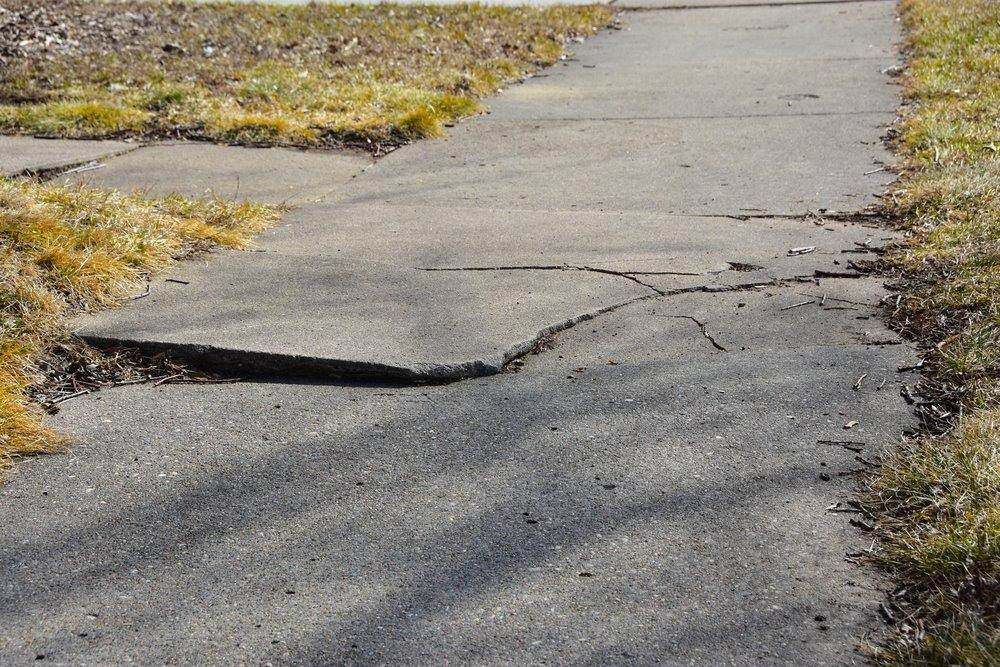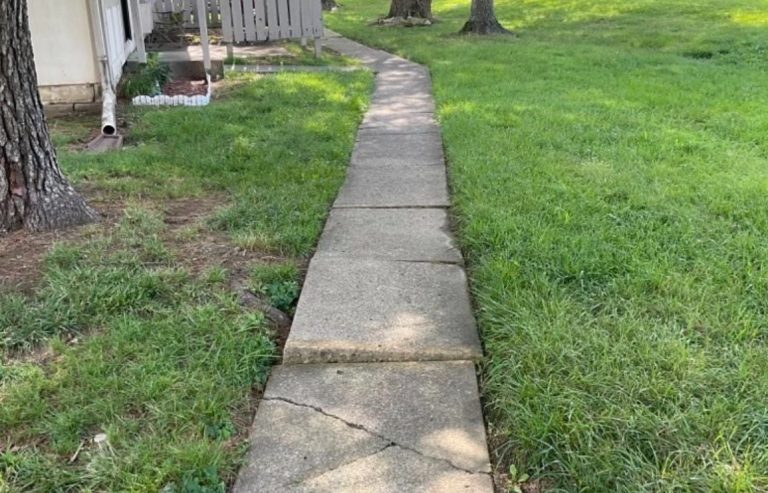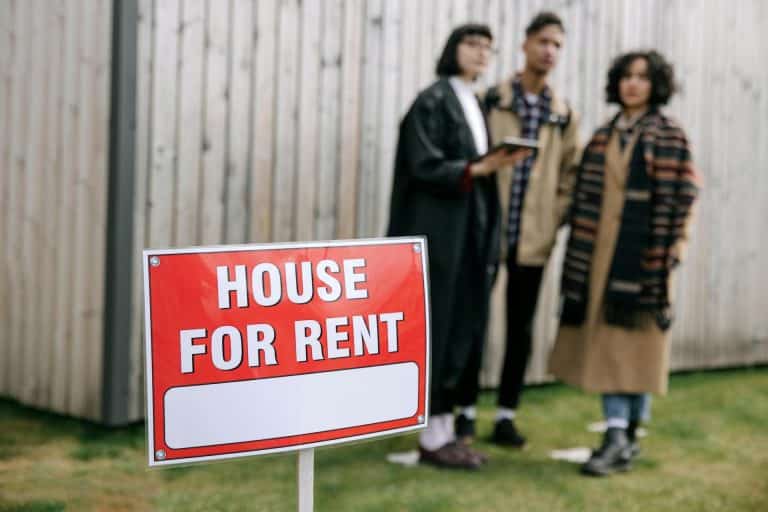If you’ve ever taken a walk through your neighborhood and stumbled on a raised slab of concrete near a tree, you’re not alone. Sidewalk lifting near trees is one of those common problems that sneaks up on homeowners until someone trips or the city sends a notice.
But don’t sweat it. Whether you’re a proud new homeowner or someone who just wants to keep their curb appeal sharp and their property safe, we’re going to break this down in simple terms: why it happens, why it matters, and how you can fix it without pulling your hair out.
Why Do Sidewalks Lift Near Trees?
Let’s talk about the elephant or should we say the root in the yard: tree roots. When trees grow, their roots expand outward in search of water, nutrients, and space. Over time, they can inch their way under your sidewalk, slowly pushing it up like a potato growing through cracked soil.
Here are the main culprits:
Shallow Roots
Some trees just have more attitude than others. Species like silver maples, willows, poplars, and sweetgums are known for their shallow, fast-growing root systems. Instead of growing deep into the ground, their roots stay right near the surface, just under your grass, flower beds or yes, your sidewalk.
Because those roots don’t stop when they hit concrete, they go under it. And as they grow thicker, they lift the slab like a jack under a car. If the tree is close to the sidewalk, the risk is even higher.
Soil Condition
Soil plays a big role in whether tree roots get the upper hand. If your yard has loose, sandy, or poorly compacted soil, it’s basically an open invitation for roots to spread. It’s like putting down a welcome mat that says, “Come grow here.”
Plus, soil doesn’t stay still. It expands when it gets wet and contracts when it dries, especially in areas with big temperature swings or heavy rain followed by drought. That movement puts extra pressure on whatever’s sitting on top, like your sidewalk slabs.
Even the best concrete can’t win a tug-of-war with shifting soil and sneaky roots underneath.
Old Sidewalks
Here’s the thing: sidewalks aren’t forever. If yours is 20, 30, or even 40 years old, it probably wasn’t built with the root-blocking tools we have today. Older concrete tends to be thinner, less reinforced, and often lacks expansion joints or root barriers.
So when those roots come creeping, the concrete doesn’t put up much of a fight. It cracks, lifts, and eventually starts to look like a mini skate ramp in front of your house.
Think of your old sidewalk like an aging fence. Without reinforcement, time and pressure will eventually win.
Why You Shouldn’t Ignore It?
We get it: life gets busy. And a lifted sidewalk doesn’t seem like an emergency until it becomes one. The longer you wait, the bigger the risk and sometimes, the bigger the bill.
Here’s why this isn’t something you want to put off:
Tripping Hazards
This one’s obvious, but it’s worth repeating. Raised sidewalks are dangerous, especially when you least expect it. All it takes is one wrong step and suddenly someone’s on the ground nursing a twisted ankle or worse.
- Seniors and kids are most vulnerable
- Delivery drivers and mail carriers walk these paths daily
- Even your dog could get hurt if their paw gets caught
Beyond the physical danger, you could be on the hook legally if someone gets hurt on your property. And those medical bills or legal claims? Yeah, they add up fast.
It’s not just about concrete. It’s about safety, liability, and peace of mind.
City Violations & Fines
Here’s a surprise most homeowners don’t see coming: you’re responsible for the sidewalk in front of your house, even if the tree causing the damage belongs to the city. Yep, it’s frustrating but true in New York City.
- First, you’ll get a notice
- Then, you could be fined (In case of personal injury)
- And if you don’t fix your sidewalk in time, the city might hire a contractor and send you the bill
The city of New York takes sidewalk violations seriously. They’ll not only fine you but also record the violation on your property record. That can affect resale value, home inspections, and insurance.
Pro tip: The faster you act, the better chance you have to handle it on your own terms and budget.
Curb Appeal Killer
We’ve said it before, your sidewalk is like the welcome mat to your home. When it’s lifted, cracked, or patched with mismatched concrete, it drags the whole look of your home down with it.
First impressions matter to buyers, guests, and neighbors. The beautiful landscaping cannot conceal a broken path. Uneven or cracked sidewalks ruin the look of a well-kept front yard.
And let’s be honest: it just feels better walking up to your house on a clean, even path. Whether you’re hosting friends or just grabbing the mail, a smooth sidewalk adds that little touch of pride and polish every homeowner deserves.
Think of it like this: Fixing the sidewalk by a Certified Contractor is an investment in your home’s safety and its style.
How To Fix a Lifted Sidewalk Near a Tree?
So, your sidewalk’s starting to look like a cracked jigsaw puzzle, and maybe you’ve tripped over it more than once. It’s frustrating, but the good news? You’ve got options. Whether you’re dealing with minor cracks or a serious root rebellion, there are fixes that can buy you time and long-term solutions that give you peace of mind.
But sometimes, you don’t need a full sidewalk overhaul; you just need a safe surface and a little breathing room while you weigh your options (or wait for the next paycheck).
Here’s what works when you’re not quite ready to commit to a full replacement that can smooth things over while you plan your next move.
Concrete Grinding
A simple, quick fix for slight elevation changes. Concrete grinding involves shaving down the raised edge of the slab to level it with the adjacent section. It’s efficient, relatively inexpensive, and causes minimal disruption to the tree roots below.
Think of it like sanding down a rough edge instead of replacing the whole board.
Pros:
- Budget-friendly
- No digging or heavy machinery
- Completed in just a few hours
- Keeps the tree intact
Cons:
- Not a long-term fix if the roots keep growing
- Only works for minor lifts, not broken or severely raised slabs
Best for: Small sidewalk lifts (usually under 1–2 inches). If your sidewalk has just started to lift and you want a quick fix to eliminate a trip hazard, this is a solid choice.
Crack Patching
Got surface cracks? Patching is a quick cosmetic fix that can help keep water out and prevent further cracking. You (or a pro) clean out the crack and fill it with sealant or fresh concrete.
It won’t solve major issues, but it does make your sidewalk look better and safer.
Best for: Small, shallow cracks that are not deep ones or slabs that are shifting. However, if the cracks keep coming back, though, that’s your sidewalk’s way of saying it needs more than a band-aid.
Mudjacking (Slabjacking)
This method involves drilling small holes in a sunken slab and pumping in a slurry (a mixture of cement and mud) underneath. It raises the slab back into place, kind of like fluffing a pillow that’s been squished flat.
Pros:
- Less invasive than full replacement
- Fast turnaround
- Levels the slab without removing it
Cons:
- Doesn’t address growing roots
- Won’t work if the slab is badly cracked or heaved
- Can be pricey for a short-term fix
Mudjacking is a solid temporary fix; just know you may be back in the same spot in a year or two if the roots aren’t handled.
Long-term Solution to Fix a Lifted Sidewalk

All the above repairs are effective but for the short term, until the roots come back stronger. If you are tired of patching things up and want a real and permanent solution, it’s time to dig a little deeper, literally.
Here are some long-term effective repair options.
Root Pruning (But Do It the Right Way)
Root pruning is exactly what it sounds like. Cutting back the roots that are pushing your sidewalk up. But this isn’t a job for weekend warriors with a shovel.
Certified arborists know how to trim the right roots without harming the tree. They usually follow the “25% rule,” which means they won’t remove more than a quarter of the root system. And that’s for good reason:
- Cut too many roots? The tree might fall in a storm.
- Cut the wrong ones? The tree could starve.
- Go overboard? You could kill it and be liable if it’s city-owned.
Always call a pro. DIY root pruning is a risky business.
Installing Root Barriers
If you want to stop roots from messing with your concrete long-term, root barriers are the way to go. These underground walls redirect roots so they grow deeper or in a different direction, away from your sidewalk.
They come in all kinds of materials:
- Rigid plastic or metal for maximum defense
- Flexible PVC for tight or curved spaces
- Fabric sleeves that move with the soil
How deep do they go? Usually 2 to 4 feet deep, installed in a continuous line so roots can’t sneak under. Root barriers work best when paired with root pruning and new concrete work.
Slab Replacement
Sometimes, there’s just no saving the old concrete. If your slabs are cracked, broken, or lifted several inches, replacement is the most effective and often the safest option.
A competent and reliable contractor will:
- Cut and lift the damaged slab
- Prune any roots (within legal and safety limits)
- Pour new concrete, possibly with rebar or mesh for added strength
In NYC, this can run between $300 and $1,000 per slab depending on complexity and permits. If the tree belongs to the city, get them involved early. They may cover some costs or provide free repairs under local programs if the eligibility criteria are met.
Use Flexible Sidewalk Material
Looking for something a little more eco-conscious and root-friendly? Some cities are testing alternatives to traditional concrete, including:
- Rubber sidewalks
- Interlocking pavers
- Permeable concrete
These materials flex with root growth and are less likely to crack or lift. Plus, they let water soak into the soil instead of running off into the street.
According to the USDA Forest Service, flexible paving can cut long-term maintenance costs by up to 50% in tree-heavy areas.
Not every city allows these materials yet, so check with local ordinances before swapping out concrete.
In NYC, only the concrete is being used as a standard material for sidewalks. You are not allowed to install a sidewalk using a material other than concrete unless your property belongs to some historic districts. Even then, each alternative material requires strict PDC approval and must follow specific design guidelines set by the Landmark Preservation Commission.
Important Things to Know Before You Grab a Shovel
Before you jump into repairs, there are a few things you really need to know, especially if you’re dealing with city trees or live in a regulated urban area like NYC.
Legal Responsibilities
In cities like NYC, homeowners are responsible for maintaining the sidewalk in front of their homes, even if the roots causing the damage come from city-owned trees.
If someone gets hurt on your sidewalk, you could be liable. And if you ignore the damage, you might get slapped with a violation (and a deadline to fix it).
But here’s some good news:
If you own a 1-, 2-, or 3-family home and it’s not used commercially, you might be exempt from liability for root-related damage. In that case, report the issue to NYC Parks by visiting the official site or calling 311. You might qualify for free repairs under the Trees & Sidewalks Repair Program.
Permits and Tree Rules
Urban trees are protected by local law. Cutting roots over 2 inches wide or digging too close to the trunk without a permit can land you with fines or worse, an injured (or dead) tree that you’re on the hook for.
Always call the Parks Department or urban forestry office before starting work. They’ll help you stay on the right side of the law and may even offer guidance or financial assistance.
Cost Considerations
Sidewalk work isn’t cheap, especially if it involves trees, permits, and structural work. But sometimes a bigger upfront investment (like installing root barriers or using flexible materials) saves you thousands in the long run.
Also, check with your city to see if they offer:
- Cost-sharing programs
- Tree maintenance grants
- Free inspections or repairs (like NYC does)
Environmental Impact
Somehow, the roots are causing trouble, but they’re also keeping the tree alive. Over-pruning can weaken or kill even the healthiest trees. According to the Tree Care Industry Association (TCIA), removing more than 25% of the roots can lead to instability or death.
So be kind to the trees, they’re part of your neighborhood’s beauty and health. Consider getting help from a certified arborist and let the pros strike the right balance between saving the tree and saving your sidewalk.
Conclusion
It might be tempting to ignore that bumpy sidewalk, but the risks to your safety, your wallet, and your property just aren’t worth it.
The good news? There are real, proven solutions out there. Whether you need a temporary grind, a full replacement, or a root-smart upgrade, you don’t have to choose between a walkable path and a beautiful tree canopy.
Take the time to evaluate your options, follow your city’s rules, and bring in the right pros. Your future self and your neighbors will thank you.













